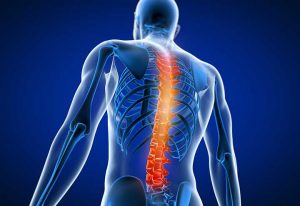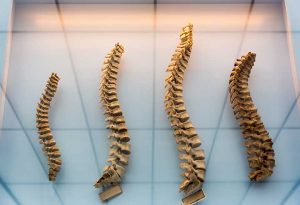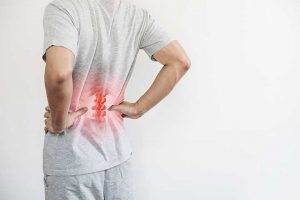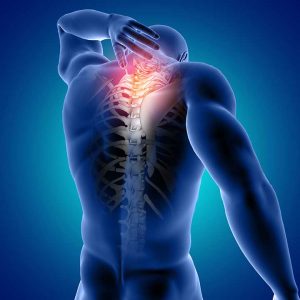Table of Contents
What is Anterolisthesis
Anterolisthesis is an abnormal spine condition in which the upper vertebral body, which is the drum-shaped region in front of each vertebra, slides forward onto the vertebra below.
This is just another name for spondylolisthesis.
The degree of slippage is graded on a scale of 1 to 4. Grade 1 is considered mild (less than 25% slippage), whereas grade 4 is considered severe (greater than 75 percent slippage). Anterolisthesis effects differ significantly depending on whether or not the slippage pinches the nerve roots and which area is affected.
As we mentioned the term spondylolisthesis, it would be fair to write the definition of it.
Spondylolisthesis is a disorder that occurs when one vertebral body slips forward over another. Spondylolisthesis is most likely due to an underlying spondylolysis condition.
Spondylolisthesis may be classified as degenerative, isthmic, dysplastic, traumatic, or pathological.
The most major reason for back pain in adolescents is isthmic spondylolisthesis, and the usual symptom is back and/or leg pain that reduces a patient’s activity level.
Patients with spondylolisthesis are frequently recommended not to engage in strenuous activity such as athletics in order to prevent neurological injury or paralysis, but cases are uncommon and, for the most part, the disorder is not severe. The majority of adolescents with spondylolisthesis have no signs of discomfort.

Anterolisthesis Symptoms
Symptoms differ based on whether the slippage is severe enough to hit the nerve roots (the section of the nerve that exits the spinal cord to bind to other areas of the body) that connect the spinal cord to the rest of the body.
The symptoms in this situation can vary depending on where the affected region is.
Anterolisthesis can be a chronic cause of extreme localized pain, or it can grow and intensify over time. Pain may be severe and sometimes affects the lower back or legs.
Inactivity and weight gain can result from mobility problems caused by pain. It may also cause bone density and muscle strength loss. Other areas of the body’s flexibility can also be compromised.
Associated Symptoms;
- The muscular spasms
- Tingling sensations over the affected area
- Loss of thermal sensations
- pain and difficulty to maintain good posture
- weakness
- difficulty walking and limited the mobility and flexibility of the body(only in severe cases)
- loss of bladder and also bowel function(only in severe cases)
Anterolisthesis Causes
Anterolisthesis is often caused by a sudden blunt force or fractures. These may be the consequence of injuries, such as in a car accident or a fall. Anterolisthesis may also be caused by strenuous physical activity, such as bodybuilding, over time.
Another major reason for anterolisthesis is aging. This happens naturally as the cartilage between the vertebrae degrades and thins over years.
Anterolisthesis may also be caused by underlying disorders such as bone weakness, arthritis, or tumors. A tumor may cause the vertebra to shift out of its normal position.
Anterolisthesis is sometimes associated with a hereditary spinal growth defect in babies.

Risk Factors
Anterolisthesis is more likely to affect older people. It typically affects people over the age of 50, with women having a higher rate of growth.
The natural aging process weakens the bones and makes them more vulnerable to injury, including anterolisthesis.
People who participate in strenuous exercise on a daily basis are more likely to develop anterolisthesis. Athletes, especially weightlifters, are among them.

Diagnostic Criteria
Anterolisthesis is diagnosed by a doctor based on a physical examination and an assessment of the patient’s symptoms. A reflex test is normally included in the study.
To confirm a suspected anterolisthesis diagnosis, X-rays, CT scans, and MRI scans may be used. These imaging methods are used to look for bone abnormalities, as well as to evaluate fractures and nerve damage.
Anterolisthesis Grading
We mentioned it earlier. According to the degree of slippage, anterolisthesis is referred to as 4 degrees. These are;
- Grade 1 – lower than 25 percent slippage.
- Grade 2 – 26 to 50 percent slippage.
- Grade 3 – 51 to 75 percent slippage.
- Grade 4 – 76 percent or more slippage.
There are extreme instances of 100 percent slippage, which occurs when the upper vertebra fully slipped from the one below.
Anterolisthesis Treatment
The degree of slippage is used by doctors to develop a care plan. People with grade 1 and 2 slippages typically have moderate symptoms, and care focuses on reducing pain and discomfort. Slippages of Grade 3 and 4 are considered serious and can necessitate surgery.
Mild slippage can be treated with a brief period of bed rest, moderate exercise, and pain medicine. Severe cases can necessitate chiropractic care and surgery. Surgery is regarded as the last option.
Rest and Medication
Bed rest can aid in the treatment of mild cases of anterolisthesis. Sporting practices and strenuous everyday activities should be avoided before the pain subsides.
Rest may also help avoid further vertebral slippage or injury.
NSAIDs (nonsteroidal anti-inflammatory drugs) can be used to relieve the pain and inflammation caused by anterolisthesis.
Certain painkillers and opioids may be needed for more severe pain. Epidural painkillers, which are injected directly into the back, can reduce inflammation and pain.

Read Rhizotomy Procedure for Back Pain
Exercise and Therapy
Exercises are often performed in combination with physical therapy. Exercise will help you move more freely, enhance your flexibility, and strengthen your back muscles.
Stabilization exercises can help to keep the spine mobile, strengthen the abdominal and back muscles, and reduce painful movement of the affected spine’s bones.
Surgical Treatment
Surgery is only used as a last resort to treat anterolisthesis. If the vertebrae begin to slip or if the pain persists after other treatments, surgery may be required.
Plates, wires, rods, or screws can be used to shift the vertebrae during surgery.
Anterolisthesis is typically treated with one of the following surgical procedures.
Decompression is the removal of bone or other tissue to relieve pressure on the vertebrae and related nerves.
Spinal fusion is a procedure in which a fragment of bone is transplanted into the back of the spine. The bone heals and joins the spine. This provides a stable bone mass that helps strengthen the spine.
A hybrid of spinal fusion and decompression can also be proposed.
Anterolisthesis Prevention
- Back and abdominal muscle strengthening exercises
- Swimming and cycling are two activities that reduce the risk of lower back injury.
- Keeping a healthy weight in order to relieve tension on the lower back
- Consuming a well-balanced diet to aid in bone strength maintenance
Takeaway
The vertebrae are the bones that circle the spinal cord and defend it. A vertebral body is a dense drum-shaped region in front of each vertebra. There are spaces between the vertebrae that enable nerves (nerve roots) to pass from the spinal cord to other areas of the body.
Anterolisthesis occurs when the upper vertebral body is located abnormally in relation to the vertebral body below it. The upper vertebral body, in particular, slides forward on the one below.
The degree of slippage is graded on a scale of 1 to 4. Grade 1 is considered mild (20% slippage), while grade 4 is considered extreme (100 percent slippage).
Frequently Asked Questions (FAQs)
Anterolisthesis Meaning?
It’s a spinal condition in which the upper vertebral body (the drum shape part of a vertebra) slides forward onto the vertebrae below.
What grade is a 2 mm Anterolisthesis?
When the vertebral body displacement is more than 2 mm (millimeter) =, then it’s called 2 mm anterolisthesis.
what is grade 1 Anterolisthesis?
When the slippage is lower than 25% then it’s called grade 1 Anterolisthesis. The grading is a diagnostic criteria.
L5-S1 level where there is a grade 2 Anterolisthesis of L5 on S1?
If the slippage is lowered than 50% but upper than 25% then it’s called grade 2 Anterolisthesis. L5 on S1 means the upper vertebra lumber 5(L5) slipped onto Secral 1(S1).
What grade is a 4 mm Anterolisthesis?
4 mm Anterolisthesis refers to grade 3.
What grade is a 6 mm Anterolisthesis?
6 mm Anterolisthesis is severe and it refers to grade 4.
Last Updated on February 23, 2022 by Learn From Doctor Team






